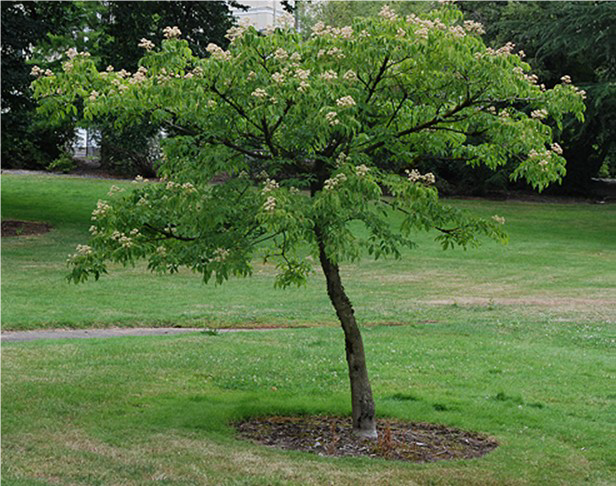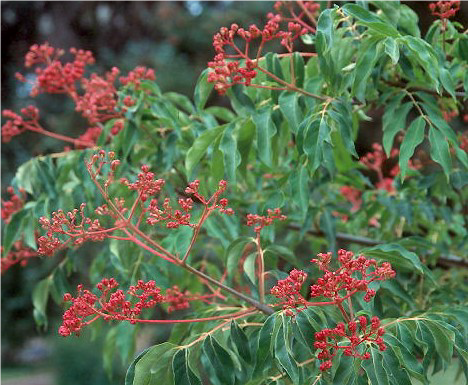Korean Evodia Tree (Bee Bee Tree)
- Valerie Just
- Aug 12, 2017
- 4 min read
NOTEWORTHY: While the Bee Bee tree provides nectar and pollen at an important time of year, you should research and make appropriate determinations for your own landscape or property. This tree has become invasive in many states; you can control the invasive nature of this tree in a formal landscape situation, but the situation becomes more perilous for large land-ownership planting.
A couple of weeks ago John came home and told me there was a tree in our neighborhood that was flowering, and when he stood under the canopy, the hum of the honey bees was very evident. We have beekeeping for the last three years, and had never heard of a tree that was in bloom in Iowa at the end of July; however, any plant that is blooming at this time of year, and one that the honey bees will visit, is enough to pique my interest. I got in the car, and he drove about a mile - our mentor also lives in this neighborhood, and he had told John about this tree.
When we got to the house, as I stood back to look at the tree, I pondered if this wasn't a tree at all, as it had multiple branches at the base of the plant. I speculated that it was possibly a very large shrub, that stood about 20 feet tall. I've seen Rose of Sharon shrubs that stand about 15 feet at the State Fair Grounds, so it certainly could be a shrub. I, like John, stood under the canopy and was amazed at the hum of the honey bees that were visiting the bloom. The bees were everywhere - thousands of bees.
I had brought my camera, so I took several pictures - at the base, close-ups of the leaf structure, and pictures of the blooms. My 89 year-old Dad is a retired forester - he got his Master's Degree from the University of Montana, and he was coming to visit in a week, so I held off doing anything with the pictures, hoping that my Dad could identify the tree. He went to look, broke off the end of a branch, as he didn't know the name of the tree. I also emailed pictures to my son, an Urban Forester for the Department of Transportation in Washington, D.C. I didn't hear back for several days, so I sent the pictures to the Extension office with the Iowa State University. Within an hour, Richard advised me that the tree was a little-known tree called a Korean Evodia, sometimes referred to as the Bee Bee Tree.
I tried to call a couple of nurseries in Des Moines to see if they had this tree, but no one did. The tree was for sale on the Internet earlier this year; there is seed that is available to purchase right now. I think I will hold out for a tree next spring; it takes six to seven years before the tree blooms; I want to get a tree that has a start on growth so I'm still alive to see the bloom!!! At this time of year to find a tree that blooms is a real boon to my bees!
Information from the Forest Service, Fact Sheet ST-242 November 1993
Korean Evodia is a little-known but highly desirable small, deciduous tree, often seen at 15 to 25 feet high with an equal or greater spread but is capable of reaching 50 feet in height (Fig. 1). Specimens reaching 50 feet tall are rare. The pinnately compound, dark green leaves cast a light shade below the tree and remain attractive and disease-free throughout the summer. The leaves often drop in autumn while still green, though some trees have been known to provide a display of clear yellow fall foliage. In early summer, many showy, flat-topped flower clusters appear, the white, fragrant blossoms attracting a multitude of bees. Following this gorgeous display of blooms is the production of ornamental, red to black fruits.
Here is some information from the University of Connecticut:
Scientific Name: Tetradium daniellii
Habitat
native to northern China and Korea
hardy to zone 4
Habit and Form
a small to medium sized deciduous tree
typical landscape size is 25' to 30'; but it can get larger
generally as wide as tall
most often found with a short main trunk that divides into several main branches
overall plant shape is somewhat vase-shaped
Summer Foliage
opposite, pinnately compound leaves
9" to 15" long leaves
generally 7 to 11 leaflets
leaflets are ovate and rounded at the base
leaf color is a dark , lustrous green
good quality summer foliage
Autumn Foliage
no fall color
greenish-yellow
Flowers
numerous small white flowers borne in flat clusters
flower clusters are 4" to 6" across
bloom time is July and August
bloom is generally heavy and showy, especially for summertime
Fruit
small capsules
change from red to black in late August through November
ornamental show from the fruit can be quite nice
Bark
smooth gray bark
possesses noticeable raised lenticels
fairly ornamental
Culture
prefers moist, fertile, well-drained soil
pH of soil not critical
full sun
young trees are less cold hardy tan mature specimens; plant as large a specimen as possible
Landscape Use
specimen
delightful in small groves or groupings
useful for summer bloom effect
useful for high quality summer foliage
good for small residences
possibly useful in urban situations
Liabilities
relatively peat free
may be weak wooded
some believe it to be short-lived
lack of full cold-hardiness in young trees
hard to locate to purchase
ID Features
opposite, pinnately compound leaves with dark green color
smooth gray bark with raised lenticels
summer bloom of flat clusters of white flowers
vase-shaped, upright habit
naked terminal buds
Propagation
by seed
Cultivars/Varieties
none




